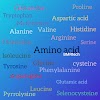Glycine | History | Chemical Properties | Structure of Glycine | Biosynthesis | Function....
GLYCINE AMINO ACID
Glycine (symbol Gly or G) is an amino acid that has a single hydrogen atom as its side chain.
Or
Glycine is one of the proteinogenic amino acids. It is encoded by all the codons starting with GG (GGU, GGC, GGA, GGG).
Glycine is integral to the formation of alpha-helices in secondary protein structure due to its compact form. For the same reason, it is the most abundant amino acid in collagen triple-helices. Glycine is also an inhibitory neurotransmitter - interference with its release within the spinal cord (such as during a Clostridium tetani infection) can cause spastic paralysis due to uninhibited muscle contraction. Glycine is a colorless, sweet-tasting crystalline solid. It is the only achiral proteinogenic amino acid. It can fit into hydrophilic or hydrophobic environments, due to its minimal side chain of only one hydrogen atom. The acyl radical is glycyl.
Properties :-
Chemical formula :- C₂H₅NO₂
Molar mass :- 75.067 g·mol−1
Appearance :- White solid
Density :- 1.1607 g/cm3[2]
Melting point :- 233 °C (451 °F; 506 K) (decomposition)
Thermodynamic data :- Phase behaviour (solid–liquid–gas)
STRUCTURE -
HISTORY :-
Glycine was discovered in 1820 by the French chemist Henri Braconnot when he hydrolyzed gelatin by boiling it with sulfuric acid. He originally called it "sugar of gelatin", but the French chemist Jean-Baptiste Boussingault showed that it contained nitrogen. The American scientist Eben Norton Horsford, then a student of the German chemist Justus von Liebig, proposed the name "glycocoll"; however, the Swedish chemist Berzelius suggested the simpler name "glycine". The name comes from the Greek word γλυκύς "sweet tastintasting" (which is also related to the prefixes glyco- and gluco-, as in glycoprotein and glucose). In 1858, the French chemist Auguste Cahours determined that glycine was an amine of acetic acid.
SYNTHESIS :-
Biosynthesis - Glycine is not essential to the human diet, as it is biosynthesized in the body from the amino acid serine, which is in turn derived from 3-phosphoglycerate, but the metabolic capacity for glycine biosynthesis does not satisfy the need for collagen synthesis. In most organisms, the enzyme serine hydroxymethyltransferase catalyses this transformation via the cofactor pyridoxal phosphate.
Degradation - Glycine is degraded via three pathways. The predominant pathway in animals and plants is the reverse of the glycine synthase pathway, the enzyme system involved is usually called the glycine cleavage system. In the second pathway, glycine is degraded in two steps. The first step is the reverse of glycine biosynthesis from serine with serine hydroxymethyl transferase. Serine is then converted to pyruvate by serine dehydratase. In the third pathway of its degradation, glycine is converted to glyoxylate by D-amino acid oxidase. Glyoxylate is then oxidized by hepatic lactate dehydrogenase to oxalate in an NAD+-dependent reaction.







0 Comments